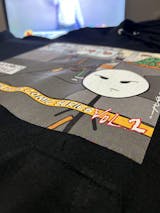We know that DTF transfer is a special printing technique. But there is much more to know about this printing technique. Many people who want to choose DTF printing continue to look for answers to some questions. One of them is how DTF transfers feel. In particular, some prints are not preferred because they are hard and uncomfortable. So what are the textural properties of DTF printing and how does it feel? In this printing process, we have provided a comprehensive content to meet your softness expectations.
Textural Properties of DTF Transfer
DTF transfers have some texture characteristics. It differs from other printing techniques with these features. This printing technique usually has a soft texture. However, it can also give a plastic feel depending on the type of fabric used. Especially when applied on polyester and nylon fabric, it can feel plastic. However, since it has a soft texture in general, the mold does not stop. Therefore, it does not cause discomfort over the clothes.
Does DTF Feel Like Vinyl?
DTF printing, as it is known, is a printing technique that can be applied on fabric or different materials with special equipment. In this case, one wonders whether it feels like vinyl. It is quite special because it feels like a soft vinyl transfer. Therefore, it does not feel hard and plastic and produces a useful print. The flexible and soft feel is one of the advantageous features of DTF transfer. Therefore, if you want a soft and skin-friendly print, you should definitely choose this printing technique.
How to Increase the Softness of DTF Transfer?
DTF transfers generally produce soft textured prints. However, it can be difficult to achieve a completely soft print, as in screen printing. Nevertheless, soft prints can be obtained when some processes are applied in this regard. Therefore, it is possible to change the textural properties of DTF transfers with some techniques. Below is information on tips for making this print softer:
Reducing the thickness of the underbase: Reducing the thickness of the sole to 50% will result in a softer print. This will further reduce the plastic feel of the print. You can adjust the substrate thickness for vibrancy and softness.
Using hot peel films correctly: Since the choice of peeling film is important, it is not recommended to choose hot peel films. Because these films may not give the softness feeling completely. You can choose warm or cold peeling films for easy peeling and softness.
Using negative space in designs: You can use negative space in your designs for a sense of softness. Halftoning techniques can also be effective at this point. Because these methods create a halftone effect, making the designs softer.
Texture and second heat press: You can experiment with finely ground powder before applying the heat press. You can achieve a softer print if you do a second press using textured material. The recommended material for this texture is pique shirt. The second heat press is generally known as a step that increases durability. However, it is also a process that ensures softness.
Use RIP software: RIP software provides a sense of smoothness, making the print more eye-catching. You can use this software to make holes in the image.
Using quality inks and coatings: To get a soft print as a result of DTF transfer, you should use quality inks and coatings. You can achieve the desired texture by using white and higher quality ink. The coating on the film is also important for softness. You can use a light coating rather than a coating that feels like a heavy coating.









